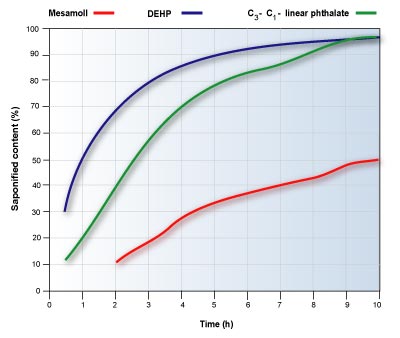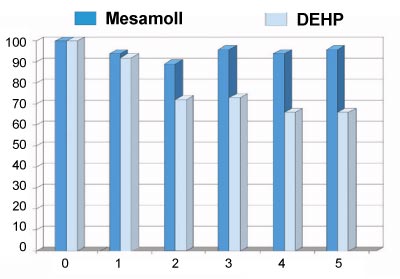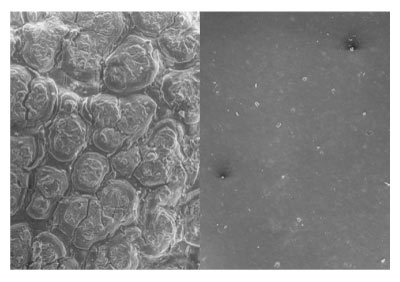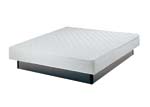
Mesamoll
2 plasticizer made by Lanxess (Bayer) for waterbed film
Bayer AG, the big german chemistry company, believes that the high level
of acceptance that waterbeds have found even among more conservative
consumers has something to do with the constant improvement in the properties
of PVC foil - the crucial component of a waterbed mattress. This special
membrane, called waterbed vinyl, has many stringent requirements to fulfill.
For
example, it needs to be sufficiently soft that potential creases in the
surface
of
the
mattress
do not become
pressure points and its seams need to be welded very securely so that
no leaks occur over the years. In addition, there are high standards
to be met in terms of tear strength and the elongation properties of
the film /foil - over the course of many years. Even though waterbeds
are not filled under pressure and the contents will at most seep out
in the
event
of a leak, the material cannot be allowed to become prematurely brittle.
For this reason, the plasticizer in waterbed films in particular
plays an important role.. In the best Qiaomenglai waterbeds,
phenol alkyl sulphonate plasticizers
- Mesamoll 2® - have proved particularly effective. These
additives are claimed to have two main advantages. They have
significantly greater saponification resistance than phthalate plasticizers
and display a much reduced tendency to migration (see Figure 1). Both of these
are particularly important for a film that is exposed to a warm, aqueous medium
throughout its whole life.
Figure 1: Stability of phenol alkyl sulphonate Mesamoll and phthalate plasticizers in terms of saponification and hydrolysis.[1] |
The loss of material caused by hydrolysis - washing out or evaporation
that can occur with plasticizers - may cause waterbed films to shrink
by up to 10% over time. This causes the brittleness of the membrane to
increase and its elasticity and elongation properties to decrease, says
the company.
Mesamoll has demonstrated its resistance to hydrolysis in harsh
weathering tests. In 5-year Florida and open-air weathering tests, PVC films
plasticized with DEHP showed a clear drop in tensile strength and elongation
at break after a few years, which can be attributed to the leaching out of
the plasticizer, says the company. However, the properties of Mesamoll-based
films are claimed to remain at a constantly high level for a long period of
time.
For example, the tensile strength and elongation at break
of PVC films plasticized with DEHP fell significantly after just two years'
open-air weathering in the North Sea climate. After five years they are reduced
to about two thirds of their original value, while with Mesamoll-based films
they remain almost at the original level (see Figure 2).
Figure 2: Change in elongation at break to DIN 53455 (%) as a function of time (years) measured using one-millimeter thick test pieces containing 35% plasticizer by weight. The elongation at break of DEHP-plasticized PVC films drops significantly after just two years. The trend in the tensile strength is comparable.[1] |
After five years in a Florida climate, test samples with DEHP only
achieve 47% of their original value for elongation at break, while those
with Mesamoll still have 83% of their starting level.
These findings also correlate with microscope images made
of the new and weathered PVC films. While the samples plasticized with phenol
alkyl sulphonic acid esters retained a smooth surface for several years, films
consisting of DEHP soon showed a fissured structure with 'islands', in which
only PVC and solid components of the formulation can be detected, when observed
under the microscope (see Figure 3). This was due to loss of plasticizer, claims
the company.
Figure 3: The reason for the gradual deterioration in the material properties and the formation of hairline fractures in PVC films in conditions promoting saponification lies in the degradation and release of plasticizers. On the right is the fissured surface of a test piece containing DEHP after two years of weathering, while on the left is a test piece plasticized with Mesamoll after more than double that length of time - magnified 40 times[1]. |
Phenol alkyl sulphonic acid esters also offer saponification resistance,
which ensures that the waterbed filling does not become a habitat for
microorganisms. Mesamoll provides no basis for life for
the bacteria and fungi that can feed on plasticizers such as DEHP. In
addition, this plasticizer is not attacked by the more aggressive cleaning
materials and that even frequent cleaning (which is desirable for hygiene
reasons) does not cause a deterioration in the PVC surface properties.
Bayer believes that the balance between tear strength and plasticity can also
be maintained with Mesamoll. According to Qiaomenglai, PVC plasticized with
Mesamoll has improved tear strength and although it is 10% stronger it is more
flexible
than other PVC grades.
The durability of the
waterbed-film material is tested in a combined ageing and impact test, and
according to the processor the material withstands 400% more impacts than
materials plasticized
using phthalates.
Finally, Bayer claims that Mesamoll has a low migration tendency and complies
with the DIN EN 71-5 standard for toys.
References:
1. Bayer Chemicals.
-----------------------------------------------------------------------------------------------------------------------
|
| ------------------------------------------------------------------------------------------------------ |
|
| ------------------------------------------------------------------------------------------------------ |
|
waterbed producer and manufacturer watermattress or waterbed mattress
Vodna postelja and Vannseng and Akvolito






